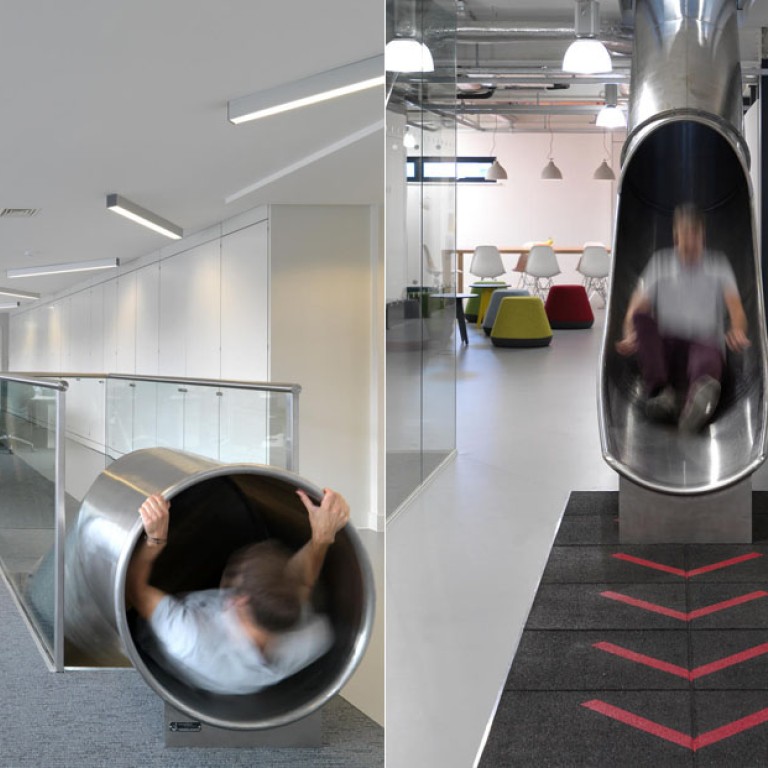
Office space makes room for fun and creativity
The corporate workplace is changing as bosses seek to boost productivity through creating an environment where staff can relax and recharge
Cosying up by the fire, jamming over drinks and chit-chatting in a cha chaan teng are not the norm during working hours - unless you happen to work in one of Hong Kong's more progressive offices.
Aaron Lau, the chief executive for Greater China at Korean creative agency Cheil, wanted the firm's Sheung Wan workplace to feel like home for his 120 employees, and engaged Bean Buro Architects to make it so.
As a trend, the blurring of lines between home and office has increased considerably since Googleplex started it, with free food and on-demand massage.
A recent global survey by real estate firm Cushman & Wakefield found that the corporate workplace is rapidly changing, with employers now citing human resource factors, such as recruiting, workforce productivity and improved work/life balance, ahead of cost factors.
Better understood, it notes, is "how changes in design can lead to improved operating performance".
The Cheil workplace was Bean Buro's third project in Hong Kong, since founders Kenny Kinugasa-Tsui and Lorène Faure moved from Britain to establish their own practice in July last year. Cheil formerly had offices in three locations across the city. Its consolidation into one site sees employees occupying three floors totalling 15,000 square feet.
The segregated cubicles of the past were the first to go, giving way to an open-plan space more conducive to the flow of creative energy. As the designers found places around the perimeter walls for pieces from Lau's personal artwork and furniture collection, the space took on a gallery-like feel. There is even space for Lau's wine collection, placed alongside a library of design books flanking the living room fireplace.
That's right - a fireplace. Some of the staff members are musicians, and sofas grouped near the flickering flames may be used for jam sessions - at other times for casual meetings or informal consultations with clients.
The office has a boardroom, although not in the traditional sense. The architects replaced the conventional conference table with a playful design of wiggly curves, made in three interchangeable parts that may be reconfigured, jigsaw-like, into a variety of seating arrangements. In a radical departure from the traditional boardroom hierarchy, the Bean Series 2 multi-purpose table is designed to put everyone on an equal footing.
In other meeting rooms in the building, staff can draw on walls. "We thought of having a blackboard [to encourage creative ideas], but then decided on black glass, which can be scribbled on with fluorescent felt pens" says Faure.
In the cha chaan teng-inspired lunch room, a row of booth seating lines one wall, a bar-height counter another. Its convivial atmosphere means that, instead of going their separate ways, staff tend to stay in for their breaks these days.
Feeling relaxed at work may well boost productivity, but in a topsy-turvy world, sleeping on the job is acceptable at some workplaces, maybe even encouraged.
Brian Halligan, the chief executive of American marketing software producer HubSpot, is one supporter of napping at work. He had a nap room installed during an expansion of the company's office in Cambridge, Massachusetts. In the Van Winkle room, staff can tiptoe across a faux grass carpet to nod off in a hammock beneath a painted cloud-dappled sky. On average, the room attracts three snoozers per day - mostly executives returning from long red-eye flights, or engineers seeking a mid-afternoon recharge before a long evening of work.
British architect Guy Hollaway realised a "brilliant idea" that came from his client - installing a giant slide inside the Workshop, a digital hub office development in Folkestone, Kent. "The client wanted to create a relaxed, fun working environment," Hollaway says. "In response to this philosophy, the upper floors are connected by an industrial slide, which provides quick circulation between the floors, providing a flexible workspace with a lively working environment."
Kinugasa-Tsui believes that finding new ways to engage employees through innovative office design is non-negotiable in today's workplace. Perhaps it is because so many work-related activities are now conducted outside the office that when staff members are on-site, "the need to gather in an office - to become more socially connected - has become more of a physical one", he says.
"That means office designs should focus on encouraging interactions, through shared space and furnishings. Furthermore, employers are increasingly aware that a 'feel-good' factor in the office encourages the staff to want to stay in the office, and in turn increases productivity. Thus the contemporary office has to respond in a more organic way to accommodate a wider range of needs, including play, games, chill-out time, relaxation, lounge space, private space, semi to fully open space, and pay more attention to the comfort of lighting, ventilation, and visual comfort [such as natural material finishes and planting]."
An on-site spa might top the list of today's workplace comforts, although two years of research has led Herman Miller, the office furniture design and manufacturing company, to deduce that it is not bells and whistles that workers really want, but a little help at home. Free house-cleaning services, take-home family dinners, babysitting and even care for elderly relatives are some of the new incentives some progressive American firms have started to offer, figuring that if stress is reduced at home, staff will be more relaxed and focused at the office. As Herman Miller concludes: "When there's a balance between work and life, everyone wins."

